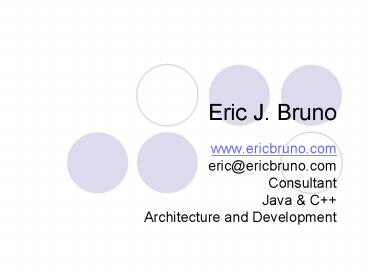Eric J' Bruno - PowerPoint PPT Presentation
1 / 35
Title:
Eric J' Bruno
Description:
The communication between and within components of a software system. More than JMS ... listener implements the new EventListenerDist interface, instead of ... – PowerPoint PPT presentation
Number of Views:49
Avg rating:3.0/5.0
Title: Eric J' Bruno
1
Eric J. Bruno
- www.ericbruno.com
- eric_at_ericbruno.com
- Consultant
- Java C
- Architecture and Development
2
Java Messaging
- JMS
- JavaBean Events
- Web-services
- Combining JMSand Web-services
- Distributed softwaresystems design
- Messaging framework
3
What is Messaging?
- The communication between and within components
of a software system. - More than JMS
- Components may be within the same JVM or not
- Take the same approach
4
Why is Messaging Important?
- Complexity
- Most software is not standalone
- Monolithic development is mostly history
- Web-based applications
- Mobile applications
5
Lots of Java APIs for Communication
- Java IO / NIO
- JavaBeans
- RMI
- JNDI
- JavaMail
- JMS
- JINI / JavaSpaces
- JXTA
- JAX-RPC (JAX-WS)
- JAXM
- SAAJ
- JMS
- MDB
- J2ME
- CORBA
6
JavaBean Events
- Source component
- Listener component
- Event interface
- Event object
7
JavaBean Event Downside
- JavaBean events cause dependencies
- Synchronous only
- Confined to one JVM
- Not anonymous
8
Java Event Agent
- Anonymous events
- Source and Listener completely abstracted
- Demo!
9
Java Remote Method Invocation
- Pure Java remote procedure calls
- Across JVMs
- RPCs are transparent
10
CORBA
- Object Management Group
- Allows Java / non-Java communication
- Internet Inter-ORB Protocol (IIOP)
11
Enterprise MOM (not McNabbs)
- Reliable exchange of data
- Guaranteed delivery
- Transaction support
- Asynchronous and synchronous
- Queue-based
- Reply-based
- Subscription-based
12
Message Paradigms
- Request / Reply
- Analogous to browser / Web server communication
13
Message Paradigms
- Queue-based (store-and-forward)
- Messages are persisted
- One receiver per message
14
Message Paradigms
- Subscription-based
- Multi-cast like
- Publish-and-subscribe
- One-to-many message delivery
- Anonymous
15
Combining Message Paradigms
- Quote System Example
- Demo!
16
Advanced Messaging (JMS)
- Message filtering
- Durable subscriptions
- Persistence
- Message acknowledgement
- Reliable messaging
- At-most once
- At-least once
- Once-and-only-once
- Transactions
- Message-Driven Beans (MDB)
- Queue theory
17
The Messaging Toolkit
- The JMS Façade
- Abstracts the JMS API details, including the
interfaces and setup - Quick and easy event listening
- Quick and east event sending
- Code comparison
18
The Messaging Toolkit
- The Event Distributor
- Extends JavaBean events across JVMs
- Transparent
- Uses JMS as the transport
- Developers can be JMS-agnostic
- Makes heavy use of Java Reflection
19
The Event Distributor
- Event listener implements the new
EventListenerDist interface, instead of
EventListener - package com.toolkit.messagingpublic abstract
class EventListenerDist private
EventDistributor eventDistributor
EventDistributor.getInstance() public
EventListenerDist() eventDistributor.onNew
Listener( this )
20
The Event Distributor
- Event source implements the new EventSourceDist
interface - package com.toolkit.messagingpublic abstract
class EventSourceDist private
EventDistributor eventDistributor
EventDistributor.getInstance() public
EventSourceDist() eventDistributor.onNewSo
urce( this ) public abstract String
getInterfaceNames()
21
The Event Distributor
- Uses Reflection to
- Intercept source events
- Send over JMS
- Call the correct listeners
22
The Event Distributor
- Demo!
23
Java Component Server
- JMS provides a robust message model
- Messages are safe and guaranteed
- What about your code?
- JMS client software still vulnerable to failure
- Something is needed to monitor JMS producer and
consumer code
24
Java Component Server (JCS)
- The JCS hosts producers and consumers
- You can configure multiple servers to distribute
them across - If a component fails, the JCS will detect and
restart that component - If the entire JCS server fails, another JCS will
take over - Enables cluster-like configuration for your JMS
code
25
Java Component Server (JCS)
- Any of number of servers can be clustered and
configured
26
Java Component Server (JCS)
- JCS Server B fails, Server A takes over
27
Java Component Server (JCS)
- JCS component development is easy
- Interface-based development
- Supports Queues, Pub/Sub, Request/Response
28
Java Component Server (JCS)
- Components are managed told when to start and
stop message processing - Uses Reflection to load, start, and stop
components - Provides thread management for parallel
processing across components - JCS servers use JMS themselves to send and
receive heartbear messages
29
Java Component Server (JCS)
- Provides a web-based administrative front-end
- Demo!
30
JMS SOAP Reliability
- Options
- JMS can be used within a web-service
implementation - JMS can be used between parts of an SOA-based
application - JMS can be tunneled through HTTP
- SOAP messages can transported over JMS
31
JMS SOAP Reliability
- JMS works over the Internet
32
JMS SOAP Reliability
- An adapter allows SOAP messages to be transported
over JMS
33
JMS SOAP Reliability
- SOAP over JMS, tunneled through HTTP
34
JMS SOAP Reliability
- JMSSOAPConnectionFactory class
- The javax.xml.soap classes are extended
35
JMS SOAP Reliability
- Source code
- Demo!

